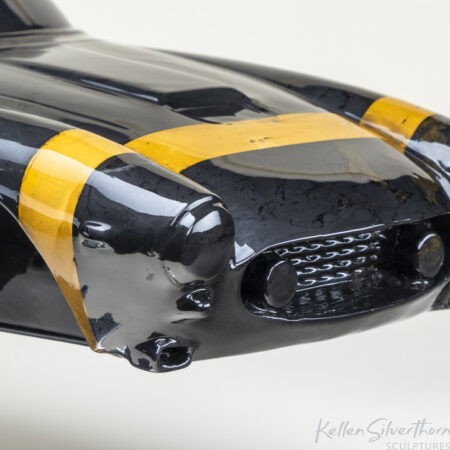En Francais – inspired by Ferrari’s 250 GT Short Wheelbase
hover and click on individual photographs to enlarge
The Ferrari 250 GT Berlinetta Short Wheel Base (SWB) embodies the Gentleman Racer ethos. Owners could drive their car to a competition venue, handily dispatch other production-based racing cars, and then drive their 250 SWB home. True, your results were better if your name was Stirling Moss, who famously campaigned Scotch Whisky scion Rob Walker’s 250 SWB.

Stirling aside Rob’s gem. Photo Credit Car Throttle
The SWB is credited to Ferrari’s then-in-house engineering triumvirate of Carlo Chiti, Giotto Bizzarrini, and Mauro Forghieri. Their beautiful SWB debuted at the October 1959 Paris Salon. It proved a huge commercial success, with roughly 170 produced and sold through early 1962. Today, these gorgeous cars are among the most cherished and sought after of all road-going Ferraris.

Competizione loose in the wild…. Photo Credit Nico K / AutoGespot
As per then-usual Ferrari practice, the 250 SWB body was penned by Pinin Farina, and said bodies series-produced by Carrozzeria Scaglietti. The disc brakes (by Dunlop), were a first for a production Ferrari. However, Enzo still insisted on a traditional live rear axle and rear leaf springs. The SWB’s 60-degree 3.0L V12 engine, with aluminum block and heads (SOHC, 2V per cylinder), ensured the car’s weight could stay less than a svelte 1000 kilos.
The ~90 customers who hoped to get some daily usage from their 250 SWB ordered Lusso spec. This brought a steel body, with aluminum opening panels, and a triple twin-downdraft Weber carbs good for ~240 hp. Bumpers, carpeting, wind-up windows, and cast-iron transmission casings imparted a degree of civility. https://www.youtube.com/watch?v=JitnDHuU8TE&ab_channel=Petrolicious

Looks like pits at Spa… Facebook
The remaining customers ordered the less-civilian-duty-tolerant Competizione specification. This spec delivered an all-aluminum body, no civility features, and a hoarier engine with six twin-downdraft Webers, good for 280 hp. The final 20-ish Competizione spec cars are often referred to as the SEFAC cars (Scuderia Enzo Ferrari Automobili Corsa). These SEFACs had lighter frames, lighter bodies, and 293 hp.

A hint of oversteer… Photo Caption VJ Images
GT racing of the era was something of an undercard to the top billing sports racers (or “prototypes”). Nevertheless, with the 250 SWB, Ferrari continued its dominance of the Tour de France in 1960-62, and won the GT Class at LeMans in both 1960-61. By Le Mans of 1962, the Chiti-Bizzarrini-Forghieri brain trust had debuted the follow-on 250 GTO Gentleman’s Racer, before themselves scattering in the soon-to-follow Maranello “palace revolt”.

Tour Auto Entry Ticket Photo Credit Sports Car Digest
The title of the sculpture will resonate with those who have taken French Language classes. Recalcitrant students get caught speaking English in class and admonished to converse En Francais ( “in French”).
My nation of Canada is officially a bilingual country of English and French. Despite efforts by generations of governments, and public-school teachers, few Anglophone Canadian adults can manage simple conversational French. I confess to being among that Anglophone majority. What I do remember most about public school French class was the oft repeated admonition “En Francais”. Fortunately, I can now repurpose the phrase to Ferrari’s 250 SWB competition success in that proud, cultured country.
THE STONE
While we picture most Ferraris painted in red, the 250 SWB is equally at home in blue, grey, silver, and yellow. Almost any hue from the rainbow works on this car. One of my first 1:18th scale die casts as a young adult was a SWB in gun metal. So, when deciding on what car to depict upon securing a supply of quality graphite, this iconic Ferrari 250 model was a natural contender for that honor.

Goodwood Revival Entry Ticket
This billet of graphite has a mild amount of gold-bronze course veining, which I find highly desirable. Like other graphite I’ve worked, it proved a fabulous stone for sculpting. It isn’t overly hard or brittle, and holds edges and detail well.
There were a number of subtle body design changes in the 250 SWB production run that spanned 1959-62. I’ve chosen to depict a 1961-62 SEFAC spec version. Race cars of this era often ran with transverse stripes across the front fenders, thought to make it easier for team managers and pit crews to appreciate handling traits from a distance.

Great panning by photographer (Sports Car Digest), else, where are the helmets Stirling?
The racing stripe inlay, and rear licence plate is from Mookaite Jasper, mined in Australia. Jasper is semi-precious, and extremely hard. Worth the effort and expense to harness such a vivid-colored stone, don’t you think?






